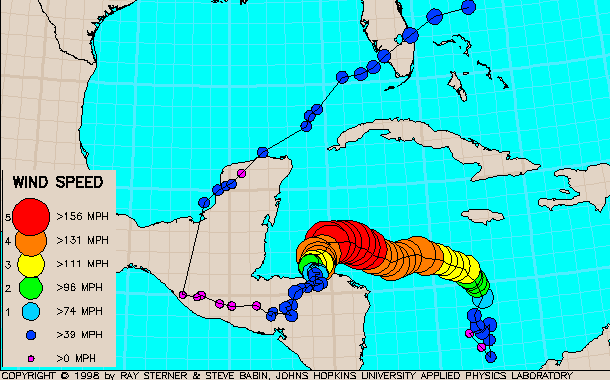Wind shear and dry air have persistently whittled away at Tropical Storm Karen. The surface circulation is now exposed almost entirely... the only deep convection to be found is 80+ miles to the southeast. Karen will pose only a minimal threat to the northern Gulf coast when it comes ashore early Sunday morning.
 |
| Enhanced infrared satellite image of Karen from 7:45am EDT. I marked the storm's center with a red X to help you find it. (NOAA) |
The wind shear (difference in wind speed and direction between low levels and upper levels of the atmosphere) is up near 30kts this morning, and may decrease to 20kts or so this evening, then ramp up to 50kts+ as it gets absorbed by a mid-latitude trough and cold front. Generally, shear over 20kts is toxic to a tropical cyclone.
Dry air also continues to infiltrate the storm's circulation... even without shear, that can be enough to choke the life out of a tropical cyclone, after all, the fundamental mechanism that drives them is latent heat release (the energy released when water vapor condenses into cloud droplets and rain). The image below is a model analysis from this morning showing mid-level winds and relative humidity. Karen is centered just south of eastern Louisiana, and the dry air (brown shades) can be seen swirling into it.
 |
| 500mb winds and relative humidity from the 06Z NAM analysis. (twisterdata.com) |
At 8am EDT, Karen was located 155 miles south of Morgan City, LA and heading north at 10mph. It is forecast to make a turn to the northeast later today. Peak sustained winds are estimated to be 40mph, but that could be generous... it's actually difficult to find observations to support that. All hurricane watches have been discontinued, but tropical storm warnings remain in effect for most of eastern LA, and a tropical storm watch extends eastward to Indian Pass, FL (
see map). This section of the Gulf coast really dodged a bullet this time... Karen could have been so much worse (think Camille, Opal, Katrina, etc).
The latest watches and warnings, as well as the track forecast, can be found on the National Hurricane Center's
website.
 |
| Early morning model analysis of surface winds, with weather station wind observations plotted. Definitely not a big wind maker for anyone! (wunderground.com) |
Storm Surge
The storm surge danger has greatly diminished - the latest models suggest a slight chance of a 2-4' surge in the New Orleans area eastward to Biloxi.
Tornadoes
As with any landfalling tropical cyclone, there is the possibility of tornadoes, and today's highest risk is extreme
southeastern LA.
Inland Flooding
Since so much of Karen's moisture is already being dissipated, the rainfall expected from it in the coming days is also decreased. The latest
5-day forecast from WPC shows most of the rain associated with Karen dwindling by the time its remnants reach Georgia.
I have
long radar loops up and running which could be interesting, but as it looks now, it will just be disorganized heavy rain well to the east of the center.


















.jpg)































